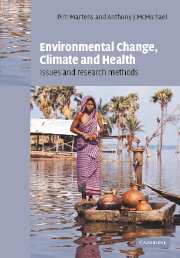Book contents
- Frontmatter
- Contents
- List of contributors
- Foreword
- 1 Global environmental changes: anticipating and assessing risks to health
- 2 Historical connections between climate, medical thought and human health
- 3 The contribution of global environmental factors to ill-health
- 4 Surprise, nonlinearity and complex behaviour
- 5 Epidemiological and impacts assessment methods
- 6 Retrospective studies: analogue approaches to describing climate variability and health
- 7 Detecting the infectious disease consequences of climate change and extreme weather events
- 8 Integrated Assessment modelling of human health impacts
- 9 Remote sensing, GIS and spatial statistics: powerful tools for landscape epidemiology
- 10 Monitoring the health impacts of global climate change
- 11 Epidemiology, environmental health and global change
- 12 Dealing with scientific uncertainties
- Index
- Plate section
- References
6 - Retrospective studies: analogue approaches to describing climate variability and health
Published online by Cambridge University Press: 28 July 2009
- Frontmatter
- Contents
- List of contributors
- Foreword
- 1 Global environmental changes: anticipating and assessing risks to health
- 2 Historical connections between climate, medical thought and human health
- 3 The contribution of global environmental factors to ill-health
- 4 Surprise, nonlinearity and complex behaviour
- 5 Epidemiological and impacts assessment methods
- 6 Retrospective studies: analogue approaches to describing climate variability and health
- 7 Detecting the infectious disease consequences of climate change and extreme weather events
- 8 Integrated Assessment modelling of human health impacts
- 9 Remote sensing, GIS and spatial statistics: powerful tools for landscape epidemiology
- 10 Monitoring the health impacts of global climate change
- 11 Epidemiology, environmental health and global change
- 12 Dealing with scientific uncertainties
- Index
- Plate section
- References
Summary
Introduction
There is a long history of man's awareness of both climate and environmental influences on his health and well-being. Hippocrates wrote his “On Airs, Waters and Places” to educate his students on the climate and geographical risk factors that could aid in the prediction and diagnosis of diseases. Early climatologists defined climate in terms of the effects on the organs of the human body (such as von Humboldt in the early nineteenth century), and weather prediction has long been based on aching corns and squeaky joints.
Extensive literature has accumulated over the last few hundred years on the associations between climate, environment and disease. However, the consistency of these associations was often found to depend on geographical location, and seldom resulted in a scientific consensus on the causative pathway. Malaria obtained its name from its presumed cause – the bad odours emanating from marshes in Italy – but this olfactorial connection is absent from many other malarious regions. Our biological and ecological knowledge regarding the dynamics of malaria has greatly improved over the last century. However, the plethora of factors that determine the outcome of disease still causes major disputes over assessing the contribution of a single factor.
Medical geography and medical climatology have existed as scientific disciplines for a long time. However, they are largely descriptive and have been of little practical significance. The current need to assess the impact of global environmental change on disease intensity and distribution has given a new relevance to these disciplines.
- Type
- Chapter
- Information
- Environmental Change, Climate and HealthIssues and Research Methods, pp. 144 - 171Publisher: Cambridge University PressPrint publication year: 2002



